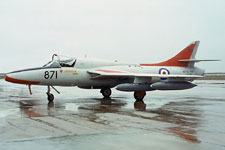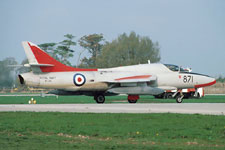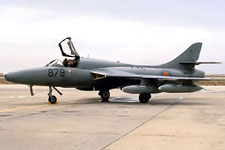| WV396's service history
This aeroplane was originally built by Hawker Aircraft Ltd at its Kingston-upon-Thames factory as a Hunter F.4 for the Royal Air Force. It took its first flight, in the hands of David Lockspeiser on 24th August 1955, and was handed over to the RAF on 23rd September at 5MU (Maintenance Unit) Kemble. It was issued to RAF 20(F) Sqn at RAF Oldenburg in West Germany as aeroplane 'F' on 4th January 1956, and remained in use with the Unit until it was moved back to Kemble in June 1957. Following a period of maintenance, WV396 was re-issued to 229OCU (Operational Conversion Unit) at RAF Chivenor in Devon on 12th August 1957, and was used on training duties for the next six years.
The Royal Navy subsequently acquired WV396 from the Royal Air Force, for conversion to T.8 specification for its Fleet Air Arm.
The transformation process took place at Dunsfold, and it was delivered to Shorts Brothers' Belfast airfield in July 1964. Moved to 5MU Kemble for storage five months later, WV396 finally entered service with a Fleet Air Arm Squadron in February 1965, when it joined 759NAS (Navy Air Squadron) at RNAS Brawdy as aeroplane '809'.
Following an engine failure at Brawdy, WV396 was moved to 5MU for a major inspection in December 1968.
It was reintroduced to service in June 1969, when it was moved to RNAS Yeovilton to join Heron Flight, where was operated as '748' for its three years with the Unit, suffering two bird-strikes in the process. On 4th August 1972, WV396 was ferried to Kemble for long-term store.
Eight years of inactivity was ended in March 1980, when British Aerospace employed it on radio trials at Bitteswell airfield.
On completion of the work it moved back to Kemble, but within two weeks it was issued to the FRADU (Fleet Requirements and Air Direction Unit) at RNAS Yeovilton as aeroplane '871'.
Operated on military taskings until May 1985, when it was moved to RAF Abingdon for a major inspection, WV396 returned to Yeovilton on 17th June 1986 with a new dark sea grey paint finish, and a new fleet number - '879'. A 'VL' shore code was also applied on the tail fin. During 1990, the aeroplane was overhauled at Hurn by Lovaux Ltd, and it returned and remained in FRADU service until May 1995, when it was flown to RAF Shawbury for storage.
Queries relating to the aeroplane's ownership prevented its sale into the private market in October 1995, and instead it was kept at RAF Shawbury in reserve.
The following year WV396 was selected for gate guardian duties at RAF Valley, and was issued with the RAF maintenance serial 9249M and moved into the Station paint-shop for re-finishing into 4FTS (Flying Training School) colours. It arrived at its new home by road on 26th November 1996, and pole mounted the following March, where it remains today.
- January 2015 |

[© Pedro Arag„o]

[© Martin Morley]

[© Pedro Arag„o]
|
